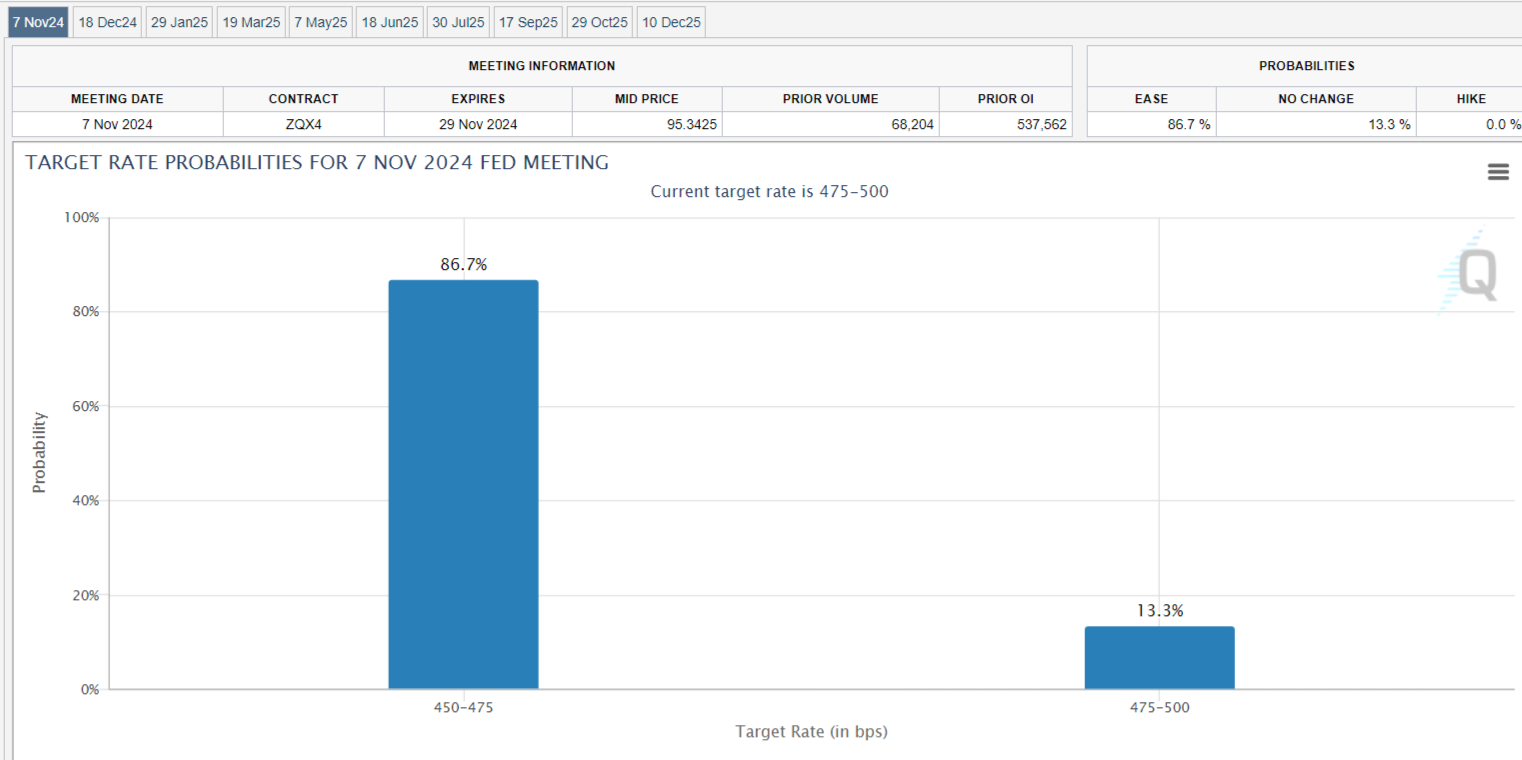A "substantial majority" of Fed officials at the September meeting backed starting a period of looser monetary policy with a significant half-point rate cut. However, there was even a broader consensus that this initial step would not lock the Fed into any specific pace for future rate cuts, according to the newly released minutes from the two-day meeting.
The Minutes from the September 17-18 gathering also noted that supporters of the half-point rate cut "observed that this adjustment in monetary policy would help align it more closely with recent inflation and labour market indicators."
However, "some" participants favored only a quarter-point cut, while "a few others" mentioned they could have supported that decision as well.
The Minutes emphasized that "it was important to convey" that the move "should not be seen as a sign of a more negative economic outlook."
In addition, the Minutes indicated that future policy adjustments would depend on incoming data, while also noting that if the economy performs as anticipated, "it would likely be appropriate to gradually shift toward a more neutral policy stance."
This section below was published as a preview of the FOMC Minutes of the September 18 Meeting at 08:00 GMT.
- The Minutes of the Fed’s September 17-18 policy meeting will be published on Wednesday.
- Details of Jerome Powell and co’s decision to trim interest rates by 50 basis points taking centre stage.
- The US Dollar Index may correct lower with the news, but the bullish path is right around the corner.
The Minutes of the US Federal Reserve’s (Fed) September 17-18 monetary policy meeting will be published on Wednesday at 18:00 GMT. Policymakers loosened the monetary policy for the first time in over four years and surprised market players with a 50 basis points (bps) interest rate cut. The decision spurred speculation officials were concerned about the economic progress and hinted at more aggressive trims.
Jerome Powell and co decided to cut rates in the September meeting
The Federal Open Market Committee (FOMC) took action after acknowledging progress towards its inflation goal. “In light of the progress on inflation and the balance of risks, the Committee decided to lower the target range for the federal funds rate by 1/2 percentage point to 4-3/4 to 5 percent,” the statement reads. However, officials also noted that “job gains have slowed, and the unemployment rate has moved up but remains low.”
The announcement was not a complete surprise, given that Powell and co somehow anticipated the decision to start trimming interest rates. What came as a surprise was the larger-than-anticipated trim, given that market participants were mostly anticipating a 25 bps cut, with only Fed Governor Michelle Bowman calling for a quarter-point cut instead.
As usual, policymakers repeated that future decisions will be made meeting by meeting based on macroeconomic data.
Meanwhile, Fed Chair Jerome Powell poured cold water on speculation the large cut came amid concerns about economic progress. In the press conference that followed the announcement, Powell said he does not see anything in the economy suggesting the likelihood of a downturn, adding that the growth rate is solid, inflation is coming down, and the labor market is “still at very solid levels.”
“We’re trying to achieve a situation where we restore price stability without the kind of painful increase in unemployment that has come sometimes with disinflation,” Powell added.
As a result, the focus shifted to employment. Tepid data released throughout September fueled speculation that the central bank would deliver another 50 bps cut when it meets in November. The US Dollar (USD) came under persistent selling pressure while stock markets cheered cheaper money.
Things changed in the first days of October. The September Nonfarm Payrolls (NFP) report released by the Bureau of Labor Statistics (BLS) showed the economy added a whopping 254,000 new jobs in the month, while the Unemployment Rate unexpectedly eased to 4.1% from 4.2% in August. Those figures clearly indicate a strong labor market, reducing concerns about it.
As a result, market players dropped bets of a 50 bps cut in November, with the odds for a 25 bps currently standing at around 85%, according to the CME FedWatch Toll.

When will FOMC Minutes be released, and how could it affect the US Dollar?
The FOMC will release the minutes of the September 17-18 policy meeting at 18:00 GMT on Wednesday. The document may explain the decision and hint at future action, but at this point, it may be old news. The NFP report indeed overshadowed any pre-release speculation about the state of the labor market.
With inflation coming down, economic growth, and solid employment-related data, it seems that the United States (US) is in the right spot to allow the Fed to reduce rates at a maybe slower but steady pace.
The Minutes will likely show that policymakers are willing to reduce the interest rate further in November, although the extent of such a cut will depend on upcoming macroeconomic data.
In fact, the US will publish the September Consumer Price Index (CPI) on Thursday, and the figures will probably have a broader impact on future Fed decisions, and hence the USD, rather than the FOMC Minutes.
Generally speaking, the more dovish the document, the more pressure there would be on the Greenback, while hawkish words should support the USD.
From a technical perspective, Valeria Bednarik, Chief Analyst at FXStreet, notes: “The US Dollar Index (DXY) seems comfortable above the 102.00 mark after flirting with the 100.00 mark in September. The overall technical stance is bullish, although another leg north is needed to confirm a sustained advance in time.”
“From a technical point of view, the DXY may correct towards 102.00 ahead of the announcement, with near-term support in the 101.90 region. Nevertheless, the daily chart shows that technical indicators hold well into positive territory, with the Momentum indicator still heading firmly north, reflecting buyers’ interest. At the same time, the DXY has overcome its 20 Simple Moving Average (SMA), which gains upward traction at around 101.20, a key dynamic support area. Finally, the 100 and 200 SMAs hold well above 103.00, limiting the mid-term bullish potential.”
Bednarik adds: “The DXY needs to conquer the 103.00 mark to extend gains at a solid pace, with the next resistance area at around 103.80. Once beyond the latter, an unlikely scenario post-FOMC Minutes, the index will enter a clearer bullish path.”
Economic Indicator
FOMC Minutes
FOMC stands for The Federal Open Market Committee that organizes 8 meetings in a year and reviews economic and financial conditions, determines the appropriate stance of monetary policy and assesses the risks to its long-run goals of price stability and sustainable economic growth. FOMC Minutes are released by the Board of Governors of the Federal Reserve and are a clear guide to the future US interest rate policy.
Read more.Last release: Wed Aug 21, 2024 18:00
Frequency: Irregular
Actual: -
Consensus: -
Previous: -
Source: Federal Reserve
Minutes of the Federal Open Market Committee (FOMC) is usually published three weeks after the day of the policy decision. Investors look for clues regarding the policy outlook in this publication alongside the vote split. A bullish tone is likely to provide a boost to the greenback while a dovish stance is seen as USD-negative. It needs to be noted that the market reaction to FOMC Minutes could be delayed as news outlets don’t have access to the publication before the release, unlike the FOMC’s Policy Statement.
Interest rates FAQs
Interest rates are charged by financial institutions on loans to borrowers and are paid as interest to savers and depositors. They are influenced by base lending rates, which are set by central banks in response to changes in the economy. Central banks normally have a mandate to ensure price stability, which in most cases means targeting a core inflation rate of around 2%. If inflation falls below target the central bank may cut base lending rates, with a view to stimulating lending and boosting the economy. If inflation rises substantially above 2% it normally results in the central bank raising base lending rates in an attempt to lower inflation.
Higher interest rates generally help strengthen a country’s currency as they make it a more attractive place for global investors to park their money.
Higher interest rates overall weigh on the price of Gold because they increase the opportunity cost of holding Gold instead of investing in an interest-bearing asset or placing cash in the bank. If interest rates are high that usually pushes up the price of the US Dollar (USD), and since Gold is priced in Dollars, this has the effect of lowering the price of Gold.
The Fed funds rate is the overnight rate at which US banks lend to each other. It is the oft-quoted headline rate set by the Federal Reserve at its FOMC meetings. It is set as a range, for example 4.75%-5.00%, though the upper limit (in that case 5.00%) is the quoted figure. Market expectations for future Fed funds rate are tracked by the CME FedWatch tool, which shapes how many financial markets behave in anticipation of future Federal Reserve monetary policy decisions.
Information on these pages contains forward-looking statements that involve risks and uncertainties. Markets and instruments profiled on this page are for informational purposes only and should not in any way come across as a recommendation to buy or sell in these assets. You should do your own thorough research before making any investment decisions. FXStreet does not in any way guarantee that this information is free from mistakes, errors, or material misstatements. It also does not guarantee that this information is of a timely nature. Investing in Open Markets involves a great deal of risk, including the loss of all or a portion of your investment, as well as emotional distress. All risks, losses and costs associated with investing, including total loss of principal, are your responsibility. The views and opinions expressed in this article are those of the authors and do not necessarily reflect the official policy or position of FXStreet nor its advertisers. The author will not be held responsible for information that is found at the end of links posted on this page.
If not otherwise explicitly mentioned in the body of the article, at the time of writing, the author has no position in any stock mentioned in this article and no business relationship with any company mentioned. The author has not received compensation for writing this article, other than from FXStreet.
FXStreet and the author do not provide personalized recommendations. The author makes no representations as to the accuracy, completeness, or suitability of this information. FXStreet and the author will not be liable for any errors, omissions or any losses, injuries or damages arising from this information and its display or use. Errors and omissions excepted.
The author and FXStreet are not registered investment advisors and nothing in this article is intended to be investment advice.
Recommended content
Editors’ Picks

AUD/USD holds below 0.6400 amid signs of easing US-China tensions
The AUD/USD pair trades in negative territory near 0.6390 during the early Asian session on Monday. The US Dollar edges higher against the Aussie amid signs of easing US-China tensions. China will hold a press conference about policies and measures on stabilizing employment and ensuring stable growth on Monday, which will be closely watched by traders.

USD/JPY holds steady above mid-143.00s amid Trump's uncertainty
USD/JPY kicks off the week on a subdued note and consolidates above mid-143.00s amid mixed cues. Investors push back expectations for an immediate BoJ rate hike amid rising economic risks from US tariffs, which acts as a headwind for the JPY and lends support to the pair amid a modest USD uptick.

Gold edges lower to near $3,300 as US-China trade tensions ease
Gold price loses ground to near $3,310 in Monday’s early Asian session, down 0.30% on the day. De-escalating trade tensions between the US and China underpins the Gold price. The fears of the US recession might help limit the Gold’s losses.

Week ahead: US GDP, inflation and jobs in focus amid tariff mess
Barrage of US data to shed light on US economy as tariff war heats up. GDP, PCE inflation and nonfarm payrolls reports to headline the week. Bank of Japan to hold rates but may downgrade growth outlook. Eurozone and Australian CPI also on the agenda, Canadians go to the polls.

Week ahead: US GDP, inflation and jobs in focus amid tariff mess – BoJ meets
Barrage of US data to shed light on US economy as tariff war heats up. GDP, PCE inflation and nonfarm payrolls reports to headline the week. Bank of Japan to hold rates but may downgrade growth outlook. Eurozone and Australian CPI also on the agenda, Canadians go to the polls.

The Best brokers to trade EUR/USD
SPONSORED Discover the top brokers for trading EUR/USD in 2025. Our list features brokers with competitive spreads, fast execution, and powerful platforms. Whether you're a beginner or an expert, find the right partner to navigate the dynamic Forex market.



